I am new to ggplot2 so please have mercy on me.
My first attempt produces a strange result (at least it's strange to me). My reproducible R code is:
library(ggplot2)
iterations = 7
variables = 14
data <- matrix(ncol=variables, nrow=iterations)
data[1,] = c(0,0,0,0,0,0,0,0,10134,10234,10234,10634,12395,12395)
data[2,] = c(18596,18596,18596,18596,19265,19265,19390,19962,19962,19962,19962,20856,20856,21756)
data[3,] = c(7912,11502,12141,12531,12718,12968,13386,17998,19996,20226,20388,20583,20879,21367)
data[4,] = c(0,0,0,0,0,0,0,43300,43500,44700,45100,45100,45200,45200)
data[5,] = c(11909,11909,12802,12802,12802,13202,13307,13808,21508,21508,21508,22008,22008,22608)
data[6,] = c(11622,11622,11622,13802,14002,15203,15437,15437,15437,15437,15554,15554,15755,16955)
data[7,] = c(8626,8626,8626,9158,9158,9158,9458,9458,9458,9458,9458,9458,9558,11438)
df <- data.frame(data)
n_data_rows = nrow(df)
previous_volumes = df[1:(n_data_rows-1),]/1000
todays_volume = df[n_data_rows,]/1000
time = seq(ncol(df))/6
min_y = min(previous_volumes, todays_volume)
max_y = max(previous_volumes, todays_volume)
ylimit = c(min_y, max_y)
x = seq(nrow(previous_volumes))
# This gives a plot with 6 gray lines and one red line, but no Ledgend
p = ggplot()
for (row in x) {
y1 = as.integer(previous_volumes[row,])
dd = data.frame(time, y1)
p = p + geom_line(data=dd, aes(x=time, y=y1, group="1"), color="gray")
}
p
This code produces a correct plot... but no legend. The plot looks like:

If I move "color" inside "aes", I now get a legend... but the colors are wrong. For example, the code:
p = ggplot()
for (row in x) {
y1 = as.integer(previous_volumes[row,])
dd = data.frame(time, y1)
p = p + geom_line(data=dd, aes(x=time, y=y1, group="1", color="gray"))
}
y2 = as.integer(todays_volume[1,])
dd = data.frame(time, y2)
p = p + geom_line(data=dd, aes(x=time, y=y2, group="2", colour="red"))
p
produces:
Why are the line colors wrong?
Charles



